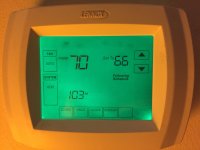BrokeFarmerJohn
Veteran Member
- Joined
- Oct 7, 2016
- Messages
- 2,233
- Location
- Columbus Ohio
- Tractor
- 2017 Mahindra 5555, John Blue G-1000, Massey Ferguson 98, John Deere GP
That being said that's what I learned in HVAC school 7-9 years ago. That's how I set my system up to swing for 2 degrees and no more.
For example my heating schedule in my stat is this. From 1pm-10pm it's 66 degrees in the house, I get home around 11pm from work, from 10pm-12am it's 68 degrees which I'm usually up watching tv around then before bed. From 12am-10am it's 66 degrees, when I'm usually sleeping ext. 10am-1pm it's 68, an average when I wake up and till I leave for work.
So it's only at 68 for 5 hours of the day, when I'm home the most and it's 66 the other 19 or so hours of the day.
I do change the temp depending if I'm hot or cold as needed but that's an example the schedule I run. Saturday and Sunday are different, those days it's mostly 68 due to heavier traffic in the house, more company ext.
For example my heating schedule in my stat is this. From 1pm-10pm it's 66 degrees in the house, I get home around 11pm from work, from 10pm-12am it's 68 degrees which I'm usually up watching tv around then before bed. From 12am-10am it's 66 degrees, when I'm usually sleeping ext. 10am-1pm it's 68, an average when I wake up and till I leave for work.
So it's only at 68 for 5 hours of the day, when I'm home the most and it's 66 the other 19 or so hours of the day.
I do change the temp depending if I'm hot or cold as needed but that's an example the schedule I run. Saturday and Sunday are different, those days it's mostly 68 due to heavier traffic in the house, more company ext.

